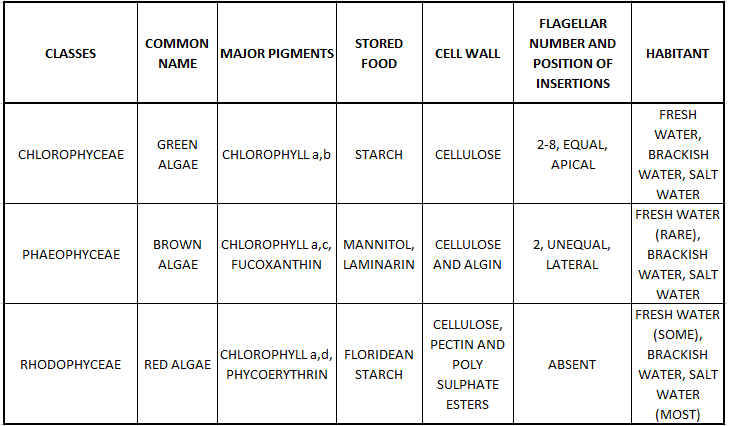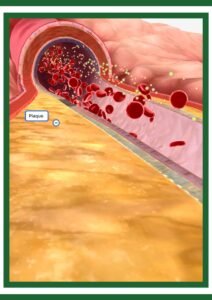NCERT 11TH STANDARD BIOLOGY – ALGAE
Algae are chlorophyll-bearing, simple, thalloid, autotrophic and largely aquatic (both fresh water and marine) organisms. They occur in a variety of other habitats: moist stones, soils and wood. Some of them also occur in association with fungi (lichen) and animals (e.g., on sloth bear). The form and size of algae is highly variable, ranging from colonial forms like Volvox and the filamentous forms like Ulothrix and Spirogyra. A few of the marine forms such as kelps, form massive plant bodies.
The algae reproduce by vegetative, asexual and sexual methods. Vegetative reproduction is by fragmentation. Each fragment develops into a thallus. Asexual reproduction is by the production of different types of spores, the most common being the zoospores. They are flagellated (motile) and on germination gives rise to new plants. Sexual reproduction takes place through fusion of two gametes. These gametes can be flagellated and similar in size (as in Ulothrix) or non-flagellated (non-motile) but similar in size (as in Spirogyra). Such reproduction is called isogamous.
Fusion of two gametes dissimilar in size, as in species of Eudorina is termed as anisogamous. Fusion between one large, nonmotile (static) female gamete and a smaller, motile male gamete is termed oogamous, e.g., Volvox, Fucus.
Algae are useful to man in a variety of ways. At least a half of the total carbon dioxide fixation on earth is carried out by algae through photosynthesis. Being photosynthetic they increase the level of dissolved oxygen in their immediate environment. They are of paramount importance as primary producers of energy-rich compounds which form the basis of the food cycles of all aquatic animals.
Many species of Porphyra,Laminaria and Sargassum are among the 70 species of marine algae used as food. Certain marine brown and red algae produce large amounts of hydrocolloids (water holding substances), e.g., algin (brown algae) and carrageen (red algae) which are used commercially. Agar, one of the commercial products obtained from Gelidium and Gracilaria are used to grow microbes and in preparations of ice-creams and jellies. Chlorella a unicellular alga rich in proteins is used as food supplement even by space travellers. The algae are divided into three main classes: Chlorophyceae, Phaeophyceae and Rhodophyceae.
Chlorophyceae
The members of chlorophyceae are commonly called green algae. The plant body may be nicellular, colonial or filamentous. They are usually grass green due to the dominance of pigments chlorophyll a and b. The pigments are localised in definite chloroplasts. The chloroplasts may be discoid, plate-like, reticulate, cup-shaped, spiral or ribbon-shaped in different species. Most of the members have one or more storage bodies called pyrenoids located in the chloroplasts.
Pyrenoids contain proteinbesides starch. Some algae may store food in the form of oil droplets. Green algae usually have a rigid cell wall made of an inner layer of cellulose and an outer layer of pectose. Vegetative reproduction usually takes place by fragmentation or by formation of different types of spores. Asexual reproduction is by flagellated zoospores produced in zoosporangia. The sexual reproduction shows considerable variation in the type and formation of sex cells and it may be isogamous, anisogamous or oogamous. Some commonly found green algae are: Chlamydomonas, Volvox, Ulothrix, Spirogyra and Chara
Phaeophyceae
The members of phaeophyceae or brown algae are found primarily in marine habitats. They show great variation in size and form. They range from simple branched, filamentous forms (Ectocarpus) to profusely branched forms as represented by kelps, which may reach a height of 100 metres. They possess chlorophyll a, c, carotenoids and xanthophylls. They vary in colour from olive green to various shades of brown depending upon the amount of the xanthophyll pigment, fucoxanthin present in them.
Food is stored as complex carbohydrates, which may be in the form of laminarin or mannitol. The vegetative cells have a cellulosic wall usually covered on the outside by a gelatinous coating of algin. The protoplast contains, in addition to plastids, a centrally located vacuole and nucleus. The plant body is usually attached to the substratum by a holdfast, and has a stalk, the stipe and leaf like photosynthetic organ – the frond. Vegetative reproduction takes place by fragmentation.
Asexual reproduction in most brown algae is by biflagellate zoospores that are pear-shaped and have two unequal laterally attached flagella. Sexual reproduction may be isogamous, anisogamous or oogamous. Union of gametes may take place in water or within the oogonium (oogamous species). The gametes are pyriform (pear-shaped) and bear two laterally attached flagella. The common forms are Ectocarpus, Dictyota,Laminaria, Sargassum and Fucus
Rhodophyceae
The members of rhodophyceae are commonly called red algae because of the predominance of the red pigment, r-phycoerythrin in their body. Majority of the red algae are marine with greater concentrations found in the warmer areas. They occur in both well-lighted regions close to the surface of water and also at great depths in oceans where relatively little light penetrates. The red thalli of most of the red algae are multicellular. Some of them have complex body organisation.
The food is stored as floridean starch which is very similar to amylopectin and glycogen in structure. The red algae usually reproduce vegetatively by fragmentation. They reproduce asexually by non-motile spores and sexually by non-motile gametes. Sexual reproduction is oogamous and accompanied by complex post fertilisation developments. The common members are: Polysiphonia,Porphyra, Gracilaria and Gelidium.


